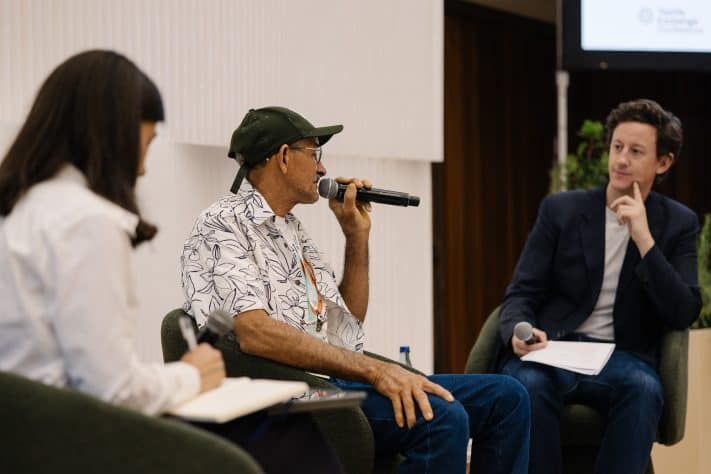Discover the key insights from the 2025 Textile Exchange Conference in Lisbon, Portugal

The 2025 Textile Exchange Conference saw more than 1,600 participants join either in person in Lisbon or online, creating a space for voices from different geographies, stages of the supply system, and lived realities to come together around a shared purpose. Under the theme of Shifting Landscapes, the agenda recognized the changing legislative, financial, and environmental contexts influencing the industry, helping attendees finding clarity amid complexity and align on collective priorities.
Here are some of the key takeaways from across the three days.
Day one
Day one set the tone for the week ahead, focusing on setting the direction of travel toward regenerative, equitable material production systems. Through sessions discussing evolving science and on-the-ground insights, the day back-casted from our desired future to map out what transition looks like in practice.
From preferred materials to preferred systems
In line with our theory of change, we discussed with a panel representing farmers and material producers how the focus on preferred materials needs to shift to preferred production systems, enabling a more outcomes-driven, holistic approach. Attendees heard how this will better reflect where the impacts occur and will recognize the interconnectivity of impacts affecting climate, nature, people, animals, and governance. This shift will allow the industry to set a clear vision and pathways toward resilient, regenerative, and circular production practices, without relying on rigid material classifications.
Both impact data and the way it’s collected must be context-specific and accessible
A number of day one’s sessions considered how high-quality, transparent, and region-specific data is critical for setting realistic goals and enabling systemic change. Day one took a deep dive into impact data for cropping production systems as well as a broader look at where the future of outcome measurement is headed. Tools like Life Cycle Assessment (LCA) must be applied thoughtfully, with awareness of limitations, within a holistic approach that includes impacts such as biodiversity, soil health, and livelihoods. Making this data accessible to all stakeholders, from farmers through to brands, is critical to driving change we can measure.
Progress demands collaboration and systems thinking
Achieving goals requires shared investment, cross-supply-chain collaboration, and aligned sourcing decisions. One of the themes of day one’s sessions was how organizations must view themselves as part of interdependent networks, recognizing partners, not just transactions, across the whole supply chain. When the supply chain speaks a common language, alignment and co-development can create solutions that enable transformation at scale.
Economic and environmental models must align, and textile-and-textile recycling offers one clear unlock
By combining economic and impact modeling, we can map out tangible pathways toward regeneration-led growth, where business objectives support, rather than compete with, sustainability goals. Textile-to-textile recycling presents one clear opportunity to get there, reducing reliance on virgin resources and unlocking the value in knowing our where our waste ends up and the ways we can repurpose it. Attendees dived into the details of post-consumer waste streams by country, exploring business strategies centered on building reverse logistics and adopting circular business models.
Standards and outcome measurement drive accountability and progres
Standards are not just verification tools, they’re frameworks for strategy, collaboration, and shared learning. Panelists discussed how measuring outcomes must be relevant, transparent, and integrated into continuous improvement cycles. While misalignments still exist (for example, between brand expectations and what farmers can actually measure), it was stressed that it’s important not to feel intimidated by complexity and to start implementing outcome measurement methods, as collective action and clear metrics are essential to scaling preferred production systems.




Day two
The second day of the conference was dedicated to exploring the interventions and enabling environments that can help the industry make progress. Sessions considered how we can overcome economic barriers to change, and leverage both policy requirements and verification mechanisms that lead to more sustainable systems.
Addressing economic barriers is essential to scaling preferred production systems
Multiple sessions discussed how economic barriers like high upfront costs, uneven risk, and limited access to finance for producers are slowing the transition needed to close the supply-demand gap, meet climate and nature goals, and safeguard livelihoods. Collective financial responsibility, through long-term contracts, blended finance, and shared investment models, is vital to ease pressure on producers and ensure an equitable shift, particularly at Tier 4 of the supply chain. A shared investment in data collection was also highlighted as critical to provide crucial evidence to peers, brands, investors, and customers that the shift to preferred production systems is a beneficial long-term strategy.
Regulation is rising—industry must engage, adapt, and lead
The textile sector is increasingly subject to tighter regulation, particularly within the EU. Attendees heard that while the EU’s simplification efforts aim to reduce administrative burdens, they also introduce new layers of uncertainty for businesses. In this rapidly changing landscape, proactive policy engagement, close monitoring of legislative developments, and advocacy for standards that enable circular systems are becoming essential business strategies. Panelists discussed how recycled content is critical, but it must be combined with sustainably sourced materials to reduce pressures from textile production, and consumption. Textile Exchange is actively involved in informing EU policy, particularly through the Policy Hub, on initiatives affecting fiber content targets, certification schemes, and Tier 4 supply chain dynamics.
Landscape-level action requires context-specific insight and collaboration
Delivering impact for climate, nature, people, and animals starts with identifying which materials offer the most potential—and where. Speakers promoted the need to screen material origins, understand regional dependencies, and assess conservation value as critical first steps. Collaboration with local stakeholders is essential to design effective, landscape-level interventions. These actions help prioritize efforts within each organization’s sphere of influence to support preferred production systems and achieve meaningful outcomes at scale.
Best practices gain power when they’re verified
Another theme of today’s sessions was how verification is essential for scaling preferred production systems. Attendees heard how it strengthens trust and transparency throughout the supply chain, supports credible sustainability claims, and helps stakeholders meet evolving legislative requirements. However, verification must be adaptable, with no one-size-fits-all approach. It must be tailored to context, scale, and purpose.
To accelerate transition, we must reach the decision makers
In a session from the Internal Enablers series, attendees explored how bridging the gap between sustainability goals and actual progress requires more effective engagement with decision-makers across businesses. This involves identifying internal champions to drive ideas forward and tailoring communication to resonate with different stakeholders. A successful approach also requires cross-departmental collaboration and an understanding of the unique priorities and KPIs of teams like legal, finance, and marketing. Panelists discussed how strategy should be twofold: looking at both what’s inside a supply chain and the external factors that influence it.




Day 3
Our final day of sessions focused on advancing landscape-level transformation that accounts for complexity, responds to lived realities, and delivers impact across climate, nature, and livelihoods. Speakers and panelists explored what it takes to accelerate progress across interconnected geographies and supply networks.
Hotspot analysis is the entry point for landscape-level action
Panelists spoke of the need to identify environmental and social “hotspots” within supply chains as a crucial first step toward implementing landscape-level solutions—enabling nature-positive outcomes on a larger scale. Attendees heard how this approach enables companies to see where fashion’s footprint overlaps with the world’s most critical ecosystems, so efforts can be prioritized where they are most needed and most likely to drive measurable impact. By integrating science into decision-making and pinpointing these areas early, businesses can align sustainability strategies with real-world conditions, setting the stage for context-specific, collaborative interventions that support both nature and communities.
Collaboration is essential for scalable, context-specific solutions
Effective landscape-level action depends on inclusive, participatory approaches. Attendees heard how having the right stakeholders in the room and identifying their roles can help enable effective projects that reflect local realities and deliver tangible outcomes. When it comes to recycling, this includes the collectors and sorters on the ground, who could offer fresh insights from their perspective of interacting with the materials on a daily basis. These methods move beyond one-size-fits-all models, ensuring interventions are both contextually relevant and impact-driven. Panelists discussed how successful partnerships make landscape-level collaboration not only meaningful, but more feasible, and more likely to succeed in the long term.
Equitable economic models at Tier 4 are vital for long-term supply chain resilience
A running theme of the conference has been how we can effectively confront and distribute the up-front cost of transitioning to preferred material production systems, ensuring premiums reach those at Tier 4. Attendees heard how equitable models must account for everyone who is needed to make that system possible, from the livelihoods of farmers changing their practices to the waste collectors fueling the potential future of textile-to-textile recycling. Embedding equity at the raw material level helps build resilient landscapes and supply chains and ensures that those most connected to the realities on the ground are central to decision-making and benefit-sharing, simultaneously helping to foresee and prevent any unintended consequences that could come with changing the status quo.
Data breakthroughs have been made—now it’s time to scale
Real progress has been made in the awareness of data’s importance and the collection of both reliable traceability and impact data. However, attendees heard how the industry continues to face traceability challenges such as fragmented systems, inconsistent data quality, and limited supplier capacity to meet new demands. We now need harmonized frameworks and clearly defined roles for tech providers, regulators, and standards bodies to scale effective data solutions across the supply chain. However, panelists shared that meaningful breakthroughs don’t wait on perfect data conditions—they start with people willing to act despite the gaps.


